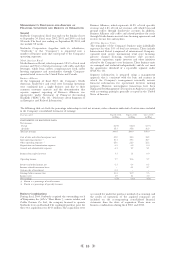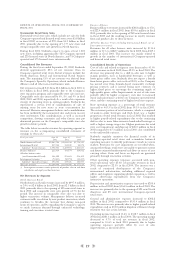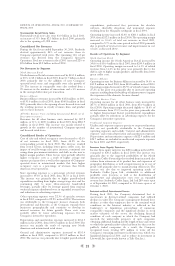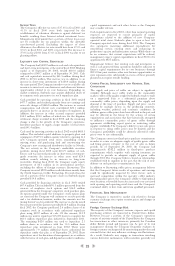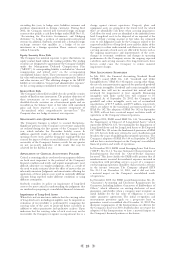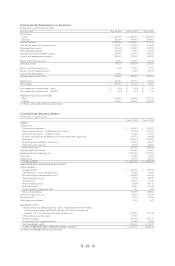Starbucks 2002 Annual Report Download - page 14
Download and view the complete annual report
Please find page 14 of the 2002 Starbucks annual report below. You can navigate through the pages in the report by either clicking on the pages listed below, or by using the keyword search tool below to find specific information within the annual report.
28
years for buildings. Leasehold improvements are amortized over
the shorter of their estimated useful lives or the related lease life,
generally ten years.The portion of depreciation expense related
to production and distribution facilities is included in “Cost of
sales and related occupancy costs” on the accompanying
consolidated statements of earnings. The costs of repairs and
maintenance are expensed when incurred, while expenditures
for refurbishments and improvements that significantly add to
the productive capacity or extend the useful life of an asset are
capitalized. When assets are retired or sold, the asset cost and
related accumulated depreciation are eliminated with any
remaining gain or loss reflected in net earnings.
Goodwill and Other Intangible Assets
The Company’s intangible assets mainly consist of goodwill,
trademarks, patents and copyrights.These assets are amortized on
a straight-line basis over the period of expected benefit, which
ranges from ten to twenty years. Starbucks will adopt SFAS No.
142, “Goodwill and Other Intangible Assets” in fiscal 2003.
Accordingly, goodwill and certain intangibles with indefinite
lives will not be amortized but instead will be reviewed for
impairment at least annually. Remaining intangibles with finite
useful lives will continue to be amortized. As of September 29,
2002, Starbucks had goodwill and other intangible assets, net of
accumulated amortization, of $19.9 million and $9.9 million,
respectively, which are subject to the transitional assessment
provisions of SFAS No. 142. The Company’s management has
determined that the adoption of SFAS No. 142 will not have a
material impact on results of operations or the Company’s
consolidated financial position.
Long-lived Assets
When facts and circumstances indicate that the carrying values
of long-lived assets, including intangibles, may be impaired, an
evaluation of recoverability is performed by comparing the
carrying value of the assets to projected future cash flows in
addition to other quantitative and qualitative analyses. Upon
indication that the carrying value of such assets may not be
recoverable, the Company recognizes an impairment loss by a
charge against current operations. Property, plant and
equipment assets are grouped at the lowest level for which there
are identifiable cash flows when assessing impairment. Cash
flows for retail assets are identified at the individual store level.
Revenue Recognition
In most instances, retail store revenues are recognized when
payment is tendered at the point of sale. Revenues from stored
value cards are recognized upon redemption. Until the
redemption of stored value cards, outstanding customer balances
on such cards are included in “Deferred revenue” on the
accompanying consolidated balance sheets. Specialty revenues,
consisting mainly of product sales, are generally recognized
upon receipt by customers. Initial non-refundable fees required
under licensing agreements are earned upon substantial
performance of services. Royalty revenues based upon a
percentage of sales and other continuing fees are recognized
when earned.All revenues are recognized net of any discounts.
Advertising
The Company expenses costs of advertising the first time the
advertising campaign takes place, except for direct-to-
consumer advertising, which is capitalized and amortized over
its expected period of future benefit, generally six to twelve
months. Net capitalized direct-to-consumer advertising costs
were $0.8 million and $0.9 million as of September 29, 2002,
and September 30, 2001, respectively, and are included in
“Prepaid expenses and other current assets” on the
accompanying consolidated balance sheets. Total advertising
expenses, recorded in “Store operating expenses” and “Other
operating expenses,” on the accompanying consolidated
statements of earnings were $25.6 million, $28.8 million and
$32.6 million in 2002, 2001 and 2000, respectively.
Store Preopening Expenses
Costs incurred in connection with the start-up and promotion
of new store openings are expensed as incurred.
Rent Expense
Certain of the Company’s lease agreements provide for
scheduled rent increases during the lease terms or for rental
payments commencing at a date other than the date of initial
occupancy. Minimum rental expenses are recognized on a
straight-line basis over the terms of the leases.
Stock-based Compensation
The Company accounts for stock-based compensation using
the intrinsic value method prescribed in Accounting Principles
Board Opinion (“APB”) No. 25,“Accounting for Stock Issued
to Employees.” Compensation cost for stock options, if any, is
measured by the excess of the quoted market price of the
Company’s stock at the date of grant over the amount an
employee must pay to acquire the stock. SFAS No. 123,
“Accounting for Stock-Based Compensation,” established
accounting and disclosure requirements using a fair-value based
method of accounting for stock-based employee compensation
plans. The Company follows the disclosure requirements of
SFAS No. 123, see Note 12, and intends to disclose stock-based
compensation information quarterly in fiscal 2003.
Foreign Currency Translation
The Company’s international operations use their local
currency as their functional currency. Assets and liabilities are
translated at exchange rates in effect at the balance sheet date.
Income and expense accounts are translated at the average
monthly exchange rates during the year. Resulting translation
adjustments are recorded as a separate component of
accumulated other comprehensive income.
Income Taxes
The Company computes income taxes using the asset and
liability method, under which deferred income taxes are
provided for the temporary differences between the financial
reporting basis and the tax basis of the Company’s assets
and liabilities.
Stock Split
On April 27, 2001, the Company effected a two-for-one stock
split of its $0.001 par value common stock for holders of
record on March 30, 2001. All applicable share and per-share
data in these consolidated financial statements have been
restated to give effect to this stock split.
Earnings Per Share
The computation of basic earnings per share is based on
the weighted average number of shares and common
stock units outstanding during the period. The computa-
tion of diluted earnings per share includes the dilutive effect
of common stock equivalents consisting of certain shares
subject to stock options.
Recent Accounting Pronouncements
In August 2001, the Financial Accounting Standards Board
(“FASB”) issued SFAS No. 144, “Accounting for the
Impairment or Disposal of Long-Lived Assets,” which
supercedes SFAS No. 121,“Accounting for the Impairment of
Long-Lived Assets and for Long-Lived Assets to Be Disposed
Of.” SFAS No. 144 retains the fundamental provisions of SFAS
No. 121, but sets forth new criteria for asset classification and
broadens the scope of qualifying discontinued operations. The
Company’s adoption of SFAS No. 144 on September 30, 2002,
will not have a material impact on the Company’s consolidated
financial position and results of operations.
In November 2001, FASB issued Emerging Issues Task Force
(“EITF”) No. 01-14, “Income Statement Characterization of
Reimbursements Received for ‘Out-of-Pocket’ Expenses
Incurred.” This Issue clarifies the FASB staff’s position that all
reimbursements received for incidental expenses incurred in
conjunction with providing services as part of a company’s
central ongoing operations should be characterized as revenue in
the income statement.The Company adopted EITF No. 01-14
on December 31, 2001, and it did not have a material impact on
the Company’s consolidated results of operations.
In November 2002, the FASB issued Interpretation No. 45,
“Guarantor’s Accounting and Disclosure Requirements for
Guarantees, Including Indirect Guarantees of Indebtedness of
Others,” which elaborates on existing disclosure of most
guarantees, and clarifies when a company must recognize an
initial liability for the fair value of obligations it assumes under
guarantee agreements.The initial recognition and measurement


